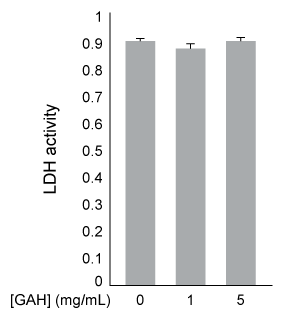Passage
Oxidative stress occurs in cells when reactive oxygen species (ROS) such as H2O2, superoxide (O2−) , and hydroxyl radicals (•OH) interact destructively with biological molecules. Several studies have indicated that histidine and certain peptides that contain histidine can decrease oxidative stress.A common marker of oxidative stress in cells is leakage of the enzyme lactate dehydrogenase (LDH) into the extracellular space. Researchers incubated cultured rat cells (PC12 cells) with H2O2 in the presence of different tripeptides, each containing one alanine, one glycine, and one histidine residue. Every possible sequence was tested, but the researchers found that the sequence GAH was the most effective in limiting extracellular LDH activity. After obtaining these preliminary results, the following experiments were conducted.Experiment 1PC12 cells were incubated with or without 5 mM H2O2 and with varying concentrations of GAH for 4 hours. Cells were centrifuged, and the supernatant (ie, extracellular material) was extracted and assayed for LDH activity (Figure 1) .
 Figure 1 Extracellular LDH activity from PC12 cells exposed to H2O2 and varying concentrations of GAH. p-values are relative to 5 mM H2O2 and 0 mg/mL GAH.Experiment 2LDH was purified and assayed for activity in the presence of 5 mM H2O2 and varying concentrations of GAH (Figure 2) .
Figure 1 Extracellular LDH activity from PC12 cells exposed to H2O2 and varying concentrations of GAH. p-values are relative to 5 mM H2O2 and 0 mg/mL GAH.Experiment 2LDH was purified and assayed for activity in the presence of 5 mM H2O2 and varying concentrations of GAH (Figure 2) .
 Figure 2 Activity of purified LDH with varying concentrations of GAHExperiment 3PC12 cells were incubated with or without 5 mM H2O2 in the presence and absence of 1 mg/mL GAH. Cells were then stained with the fluorescent marker TUNEL, which binds strongly to apoptotic cells. The percentage of apoptotic cells in each condition is shown in Figure 3.
Figure 2 Activity of purified LDH with varying concentrations of GAHExperiment 3PC12 cells were incubated with or without 5 mM H2O2 in the presence and absence of 1 mg/mL GAH. Cells were then stained with the fluorescent marker TUNEL, which binds strongly to apoptotic cells. The percentage of apoptotic cells in each condition is shown in Figure 3.
 Figure 3 Percentage of apoptotic cells in the presence or absence of H2O2 and GAH
Figure 3 Percentage of apoptotic cells in the presence or absence of H2O2 and GAH
-The purpose of measuring purified LDH activity with various amounts of GAH was most likely:
A) to demonstrate that GAH does not directly inhibit LDH.
B) to determine baseline extracellular LDH activity.
C) to show that GAH is an effective LDH antagonist.
D) to characterize the GAH-LDH binding site.
Correct Answer:
Verified
Q288: Passage
Oxidative stress occurs in cells when reactive
Q289: Passage
Glycolysis and gluconeogenesis are tightly regulated, opposing
Q290: Passage
Oxidative stress occurs in cells when reactive
Q291: Passage
Glycolysis and gluconeogenesis are tightly regulated, opposing
Q292: The Km of an enzyme is always
Q294: Passage
Glycolysis and gluconeogenesis are tightly regulated, opposing
Q295: Passage
Destabilase, an enzyme found in the saliva
Q296: Passage
Glycolysis and gluconeogenesis are tightly regulated, opposing
Q297: Certain RNA molecules can fold into structures
Q298: An enzyme generates a Lineweaver-Burk plot with
Unlock this Answer For Free Now!
View this answer and more for free by performing one of the following actions

Scan the QR code to install the App and get 2 free unlocks

Unlock quizzes for free by uploading documents